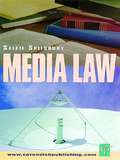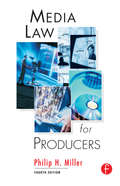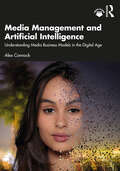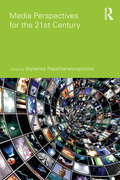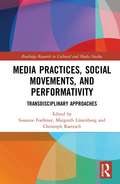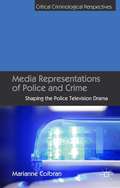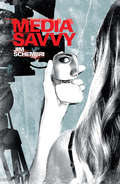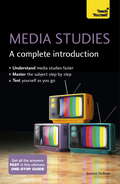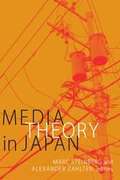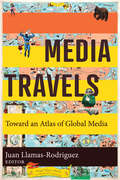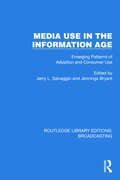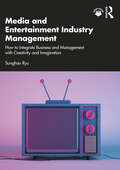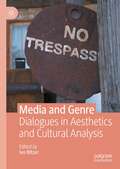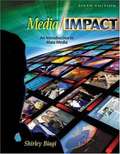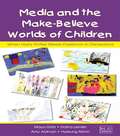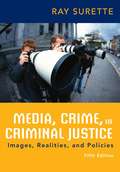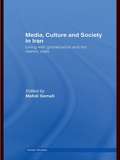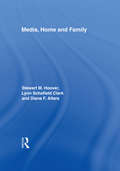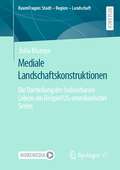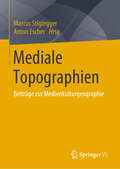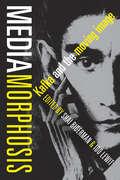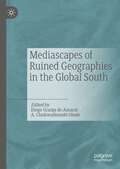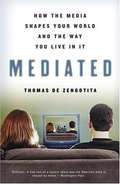- Table View
- List View
Media History and the Archive
by Craig RobertsonBy the time readers encounter academic history in the form of books and articles, all that tends to be left of an author’s direct experience with archives is pages of endnotes. Whether intentionally or not, archives have until recently been largely thought of as discrete collections of documents, perhaps not neutral but rarely considered to be historical actors.This book brings together top media scholars to rethink the role of the archive and historical record from the perspective of writing media history. Exploring the concept of the archive forces a reconsideration of what counts as historical evidence. In this analysis the archive becomes a concept that allows the authors to think about the acts of classifying, collecting, storing, and interpreting the sources used in historical research. The essays included in this volume, from Susan Douglas, Lisa Gitelman, John Nerone, Jeremy Packer, Paddy Scannell, Lynn Spigel, and Jonathan Sterne, focus on both the theoretical and practical ways in which the archive has affected how media is thought about as an object for historical analysis.This book was published as a special issue of The Communication Review.
Media Law
by Sallie SpilsburyThe aim of this book is to analyse media law in relation to specific areas,both in terms of its practical application and its theoretical framework. Part 1 concentrates on the regulation of media content and is largely written from a pro media point of view. Its central tenet is how far does the English media enjoy freedom of expression and the way in which that impacts on how the media operates. It considers how the Human Rights Act 1998 impacts on the media. Part 2 moves on to look at the regulation of the media industries as a whole. Part 3 focuses on day to day transactions for the media. In particular it focuses on provisions from typical media agreements and aims to provide a context for the law which has been outlined in Parts 1 and 2. The structure of this book bridges the gap between a traditional textbook and practitioner work and provides a book which will be of interest to law degree and LPC students and practitioners.
Media Law for Producers
by Philip MillerMedia Law for Producers is a comprehensive handbook that explains, in lay terms, the myriad legal issues that the producer will face on a regular basis - contracts, permits, defamation, patents, releases and insurance, libel, royalties and residuals, as well as protecting the finished production. This revised and expanded edition includes such Internet-related topics as Internet music law, online registration, and online privacy. Other new topics covered include:· Implied and express contracts in the project/idea submission process · Assignment/transfer of copyright· Music clip licensing· Use of other people's trademarks in media production· Parody as a defense to copyright infringement Clear explanations examine the how and why of different types of production contracts, and checklists provide a quick means for producers to determine when their productions might be at greatest risk to legal challenges. Media Law for Producers also examines the substantial changes in copyright term resulting from recent copyright legislation. Legal problems can be very costly to media producers. Lawyers and court fees, coupled with the loss of work time, can lead to bankruptcy. Media Law for Producers cuts through the legalese and illustrates legal issues to help producers recognize the legal questions that can arise during production.
Media Management and Artificial Intelligence: Understanding Media Business Models in the Digital Age
by Alex ConnockThis cutting-edge textbook examines contemporary media business models in the context of Artificial Intelligence (AI) and digital transformation. AI has dramatically impacted media production and distribution, from recommendation engines to synthetic humans, from video-to-text tools to natural language models. "AI is really the change agent of the media industry," answered a natural language generation model when AI was ‘asked’ about the subject of this book. "It will open incredible opportunities." This book seeks to explore them. The media is examined through four sections. ‘Principles’ maps business models and the key tools of AI. ‘Platforms’ covers distribution channels in Games, Streamers, Social Networks, Broadcast and Digital Publishing. ‘Producers’ covers the engines of content-making, including Scripted, Entertainment, Factual, Content Marketing, Creators and Music. Finally, ‘Pioneers’ covers emerging sectors of Podcasting, Esports, the Metaverse and other AI-driven developments. Then in each chapter, a standard value creation model is applied, mapping a single sector through development, production, distribution and monetisation. Diverse case studies are analysed from India, Nigeria, South Korea, South Africa, France, the Netherlands, the US, the UK, Denmark and China – around creative entrepreneurship, revenue models, profit drivers, rights and emerging AI tools. Questions are provided for each case, whilst chapter summaries cement learning. Applied and technology-focused, this text offers core reading for advanced undergraduate and postgraduates studying Media Management – or the relationship between Entertainment, Media and Technology. Online resources include chapter-by-chapter PowerPoint slides and an Instructor’s Manual with further exercises and case studies.
Media Perspectives for the 21st Century (Communication and Society)
by Stylianos PapathanassopoulosMedia Perspectives for the 21st Century brings together key international scholars to explore concepts, topics and issues concerning the communication environment in contemporary democratic societies. It combines qualitative and quantitative approaches to provide an interdisciplinary and truly global perspective that reflects the trends, theories and issues in current media and communication research. The collection raises significant questions about the study of the media by challenging approaches to major media and societal issues, and analyses in more depth the range of concerns that shape both the present and the future media landscape and the issues these can create for communication. It also investigates the main effects of technological developments on the domain of the news media and journalism. Divided into two main sections, Part I provides accounts of the role of the media in society, and deals with agendas that affect the field of communications studies. Part II goes on to examine the world of new media and offers analyses on the developments of the 21st century. Chapters deal with various dimensions of media from a number of different perspectives and socio-political contexts, covering a wide range of topics including Social Networking, Political Communication, Public Journalism, Global Infotainment and Consumer Culture. Media Perspectives for the 21st Century will be highly useful to undergraduate and postgraduate students, as well as researchers and academics, in the fields of media and communication studies, mass communication, journalism and new media.
Media Practices, Social Movements, and Performativity: Transdisciplinary Approaches (Routledge Research in Cultural and Media Studies)
by Margreth Lünenborg Susanne Foellmer Christoph RaetzschAs individuals incorporate new forms of media into their daily routines, these media transform individuals’ engagement with networks of heterogeneous actors. Using the concept of media practices, this volume looks at processes of social and political transformation in diverse regions of the world to argue that media change and social change converge on a redefinition of the relations of individuals to larger collective bodies. To this end, contributors examine new collective actors emerging in the public arena through digital media or established actors adjusting to a diversified communication environment. The book offers an important contribution to a vibrant, transdisciplinary, and international field of research emerging at the intersections of communication, performance and social movement studies.
Media Representations of Police and Crime
by Marianne ColbranThis unique book explores the social processes which shape fictional representations of police and crime in television dramas. Exploring ten leading British and European police dramas from the last twenty-five years, Colbran, a former scriptwriter, presents a revealing insight into police dramas, informed by media and criminological theory.
Media Savvy
by Jim SchembriWhile on work experience with a TV news crew, 16 year-old Cobey Miles suddenly finds herself in front of the camera covering a breaking news story about two bodies being uncovered in the ice. She proves an instant hit and her burgeoning modelling career starts to skyrocket. But when she sniffs something fishy behind the scenes at the station, Cobey realises that the story she has to tell is something certain people do not want to hear. Cobey is ultimately faced with a hard choice: leave the story alone and seize upon the success she is enjoying, or reveal the truth and risk consequences that may endanger her career ? or her life. From the acclaimed author of MURDER IN AISLE 9, WELCOME TO MINUTE 16 and THE EIGHT LIVES OF STULLIE THE GREAT, Jim Schembri once again scripts a fast-paced and edgy novel, laced with humorous writing.
Media Studies: A Complete Introduction: Teach Yourself
by Joanne HollowsWritten by an academic and researcher with over twenty years' experience in teaching and convening Media Studies courses, Media Studies: A Complete Introduction is designed to give you everything you need to succeed, all in one place. It covers the key areas that students are expected to be confident in, outlining the basics in clear jargon-free English, and then providing added-value features like case studies, and even lists of questions you might be asked in your seminar or exam.The book uses a structure that mirrors the way Media Studies is taught on many university courses. Chapters include essential coverage of the history, organization and production of the media industries, and regulation of the media. The analysis of media texts is covered in detail, as are the issues of identity and gender, the idea of globalization and the shifting face of social media in its many contexts.
Media Theory in Japan
by Alexander Zahlten Marc SteinbergProviding an overview of Japanese media theory from the 1910s to the present, this volume introduces English-language readers to Japan's rich body of theoretical and conceptual work on media for the first time. The essays address a wide range of topics, including the work of foundational Japanese thinkers; Japanese theories of mediation and the philosophy of media; the connections between early Japanese television and consumer culture; and architecture's intersection with communications theory. Tracing the theoretical frameworks and paradigms that stem from Japan's media ecology, the contributors decenter Eurocentric media theory and demonstrate the value of the Japanese context to reassessing the parameters and definition of media theory itself. Taken together, these interdisciplinary essays expand media theory to encompass philosophy, feminist critique, literary theory, marketing discourse, and art; provide a counterbalance to the persisting universalist impulse of media studies; and emphasize the need to consider media theory situationally. Contributors. Yuriko Furuhata, Aaron Gerow, Mark Hansen, Marilyn Ivy, Takeshi Kadobayashi, Keisuke Kitano, Akihiro Kitada, Thomas Looser, Anne McKnight, Ryoko Misono, Akira Mizuta Lippit, Fabian Schäfer, Marc Steinberg, Tomiko Yoda, Alexander Zahlten
Media Travels: Toward an Atlas of Global Media
by Juan Llamas-RodriguezMedia Travels: Toward An Atlas of Global Media fills a significant gap in global media scholarship by offering short, readable articles covering different types of media from around the world. Through careful and informed analysis, these eleven accessibly written chapters illustrate the particularities of different media practices and situate them within social, historical, and geographical contexts. Examples range from South African video games to Korean TV series popular in Latin America to Indigenous film and media from the US and Canada. Media studies courses, particularly introductory courses, are often narrowly focused on US and Western European canons. Instructors for introductory media studies courses wishing to expand the offerings in their curricula will find in these essays new ways of approaching foundational concepts and issues in the field, including globalization, social difference, and diverse media cultures. Scholars wishing to expand their research into specific media forms or representational issues can also turn to these case studies for approaches from beyond the US. By including a variety of media and several geographical areas, the collection introduces readers to the formal, technological, and cultural diversity of global media studies. Edited by Juan Llamas-Rodriguez with contributions from Anthony Adah and Añulika Agina, Maria Corrigan, Benjamin Han, Anna Shah Hoque, Meryem Kamil, Angelica Marie Lawson, Lilia Adriana Perez Limon, Sonia Robles, Kuhu Tanvir, David Tenorio, and Rachel van der Merwe.
Media Use in the Information Age: Emerging Patterns of Adoption and Consumer Use (Routledge Library Editions: Broadcasting #27)
by Jerry L. SalvaggioMedia Use in the Information Age (1989) analyses new technologies, their impact on mass communications, and their effects on the users of these new systems. It looks at technologies such as videotex, and their successes and failures around the world, and examines the early adoptions of technologies such as home computers.
Media and Entertainment Industry Management: How to Integrate Business and Management with Creativity and Imagination
by Sunghan RyuThe media and entertainment industry (MEI) differs significantly from traditional industries in many respects. Accordingly, the management of strategy, marketing and other business practices in the MEI necessitates a unique approach. Sunghan Ryu offers students focused and relevant insights into critical topics, illustrated by vivid examples from the MEI. Unlike typical introductory textbooks on business and management, this book does not overemphasize complicated layers of theory. Instead, it presents essential concepts and frameworks in a digestible manner and supplements them with opportunities to apply this knowledge to real-world cases. The textbook demonstrates how knowledge can be constructively implemented in business and management scenarios. It is structured into 12 chapters, divided into five core modules: (1) Overview of the MEI, (2) The Fundamentals of Management, (3) Marketing Management, (4) Digital Business and Management, and (5) New Business Models and Entrepreneurship. Students will gain the ability to explain key concepts and frameworks across core business and management domains and develop analytical skills through diverse real-world cases in the MEI. Based on this knowledge, they will be equipped to identify management-related issues in the MEI and arrive at practical and effective solutions.This book is an essential guide for students who wish to understand business and management in the dynamic world of the MEI.
Media and Genre: Dialogues in Aesthetics and Cultural Analysis
by Ivo RitzerThis book reflects and analyzes the relationship between media and genre, focusing on both aesthetics and discursive meaning. It considers genres as having a decisive impact on media cultures, either in film, on TV, in computer games, comics or radio, on the level of production as well as reception. The book discusses the role of genres in media and cultural theory as a configuration of media artifacts that share specific aesthetic characteristics. It also reflects genre as a concept of categorization of media artifacts with which the latter can be analyzed under terms depending on a specific historical situation or cultural context. A special focus is placed on trans-media perspectives. Even as genres develop their own traditions within one medium, they reach beyond a media-specific horizon, necessitating a double perspective that considers the distinct recourse to genre within a medium as well as the trans-media circulation and adaption of genres.
Media and Impact: An Introduction to Mass Media
by Shirley BiagiTaking an industry-by-industry approach to media issues and situating these in a global context, this textbook considers the media's influence on both individuals and whole societies. A companion CD-ROM contains CNN video clips and other supplemental materials. Biagi teaches at California State University at Sacramento. Annotation ©2004 Book News, Inc. , Portland, OR (booknews. com)
Media and the Affective Life of Slavery
by Allison PageHow media shapes our actions and feelings about race Amid fervent conversations about antiracism and police violence, Media and the Affective Life of Slavery delivers vital new ideas about how our feelings about race are governed and normalized by our media landscape. Allison Page examines U.S. media from the 1960s to today, analyzing how media culture instructs viewers to act and feel in accordance with new racial norms created for an era supposedly defined by an end to legal racism.From the classic television miniseries Roots to the edutainment video game Mission 2: Flight to Freedom and the popular website slaveryfootprint.org, Media and the Affective Life of Slavery provides an in-depth look at the capitalist and cultural artifacts that teach the U.S. public about slavery. Page theorizes media not only as a system of representation but also as a technology of citizenship and subjectivity, wherein race is seen as a problem to be solved. Ultimately, she argues that visual culture works through emotion, a powerful lever for shaping and managing racialized subjectivity. Media and the Affective Life of Slavery delivers compelling, provocative material and includes a wealth of archival research into such realms as news, entertainment, television, curricula, video games, and digital apps, providing new and innovative scholarship where none currently exists.
Media and the Make-Believe Worlds of Children: When Harry Potter Meets Pokemon in Disneyland (Routledge Communication Series)
by Dafna Lemish Maya Gotz Hyesung Moon Amy AidmanMedia and the Make-Believe Worlds of Children offers new insights into children's descriptions of their invented or "make-believe" worlds, and the role that the children's experience with media plays in creating these worlds. Based on the results of a cross-cultural study conducted in the United States, Germany, Israel, and South Korea, it offers an innovative look at media's role on children's creative lives.This distinctive volume:*outlines the central debates and research findings in the area of children, fantasy worlds, and the media;*provides a descriptive account of children's make-believe worlds and their wishes for actions they would like to take in these worlds;*highlights the centrality of media in children's make believe worlds;*emphasizes the multiple creative ways in which children use media as resources in their environment to express their own inner worlds; and*suggests the various ways in which the tension between traditional gender portrayals that continue to dominate media texts and children's wishes to act are presented in their fantasies.The work also demonstrates the value of research in unveiling the complicated ways in which media are woven into the fabric of children's everyday lives, examining the creative and sophisticated uses they make of their contents, and highlighting the responsibility that producers of media texts for children have in offering young viewers a wide array of role models and narratives to use in their fantasies. The downloadable resources provide full-color images of the artwork produced during the study.This book will appeal to scholars and graduate students in children and media, early childhood education, and developmental psychology. It can be used in graduate level courses in these areas.
Media, Crime, and Criminal Justice (5th Edition)
by Ray Surette<i>Media, Crime, and Criminal Justice</i> is the definitive text on media and criminal justice. The book features impeccable scholarship, a direct and approachable style, and an engaging format--supported by visual examples and sidebar material that complements the narrative. With the ever-increasing role of media in both reporting crime and shaping it into infotainment, the importance of the interplay between contemporary media and the criminal justice system is greater today than ever before. Author Ray Surette comprehensively surveys this interplay and showcases its impact, emphasizing that people use media-provided knowledge to construct a picture of the world and then act based on this constructed reality.
Media, Culture and Society in Iran: Living with Globalization and the Islamic State (Iranian Studies)
by Mehdi SematiBy exploring topics such as the Internet, print press, advertising, satellite television, video, rock music, literature, cinema, gender, religious intellectuals, and secularism, this unique and wide-ranging volume explains Iran as a complex society that has successfully managed to negotiate and embody the tensions of tradition and modernity, democracy and theocracy, isolation and globalization, and other such cultural-political dynamics that escape the explanatory and analytical powers of all-too-familiar binary relations. Featuring contributions from among the best-known and emerging scholars on Iranian media, culture, society, and politics, this volume uncovers how the existing perspectives on post-revolutionary Iranian society have failed to appreciate the complexity, the paradoxes and the contradictions that characterize life in contemporary Iran, resulting in a general failure to explain and to anticipate its contemporary social and political transformations.
Media, Home and Family
by Stewart M. Hoover Lynn Schofield Clark Diane F. AltersBased on extensive fieldwork, this book examines how parents make decisions regulating media use, and how media practices define contemporary family life.
Mediale Landschaftskonstruktionen: Die Darstellung des (sub)urbanen Lebens am Beispiel US-amerikanischer Serien (RaumFragen: Stadt – Region – Landschaft)
by Julia KlumpeIn diesem Buch erfolgen aus sozialkonstruktivistischer Perspektive eine qualitative Repräsentationsanalyse sowie eine quantitative Rezeptionsanalyse der drei US-amerikanischen Serien Gilmore Girls, Desperate Housewives und How I Met Your Mother. Die Autorin untersucht zum einen, welchen Einfluss die in den Serien gezeigten Landschaften auf die Wahrnehmung US-amerikanischer Landschaften durch die Rezipient*innen haben und stellt zum anderen heraus, inwieweit durch die dargestellten Landschaften Idealbilder konstruiert werden. Im Zentrum der Rezeptionsanalyse steht die Korpusanalyse entsprechender Fan-Foren. Untersucht wird, wie filmische Texte, insbesondere filmische Landschaften, in populäre Diskurse eingebettet werden.
Mediale Topographien: Beiträge zur Medienkulturgeographie
by Marcus Stiglegger Anton EscherFilmwissenschaftliche Analyse und die Methodik der Kulturgeographie werden in diesem neuartig perspektivierten Band zusammengeführt, um die medialen Topographien und Raumentwürfe des narrativen Films zu erkunden. Neben definitorischen Kapiteln zu Grundbegriffen der Filmgeographie finden sich Reflexionen zu den mythischen Räumen des Films, zur medialen Konstruktion ikonischer Orte (Casablanca, Tanger) sowie über die filmische Adaption von Grenz-Räumen und Konflikten (USA/Mexiko).
Mediamorphosis: Kafka and the Moving Image
by Shai Biderman Ido LewitThe idea of a visual manifestation of the work of Franz Kafka was denied by many—first and foremost by Kafka himself, who famously urged his publisher to avoid an image of an insect on the cover of Metamorphosis. Be that as it may, it is unlikely that such a central progenitor of twentieth-century art and thought as Kafka can be fully understood without reference to the revolutionary artistic medium of his century: cinema.Mediamorphosis compiles articles by some of today's leading forces in the scholarship of Kafka as well as film studies to provide a thorough investigation of the reciprocal relations between Kafka's work and the cinematic medium. The volume approaches the theoretical integration of Kafka and cinema via such issues as the cinematic qualities in Kafka's prose and the possibility of a visual manifestation of the Kafkaesque. Alongside these debates, the book investigates the capacity of cinema to incorporate and express the unique qualities of a Kafkaesque world through an analysis of cinematic adaptations of Kafka's prose, such as Michael Haneke's The Castle (1997) and Straub-Huillet's Class Relations (1984), as well as films that carry a more subtle relation to Kafka's oeuvre, such as the cinematic works of David Cronenberg, the films of the Coen brothers, Chris Marker's "film-essay," Charlie Chaplin's tramp, and others.
Mediascapes of Ruined Geographies in the Global South
by Diego Granja do Amaral A. Chukwudumebi ObuteThis book undertakes an interdisciplinary and cross-cultural interrogation of the Global South through the prisms of media and cultural studies. It closely explores the quotidian (re)territorialization, and brazen ruination of the material geographies of this vast expanse of the world by forces and proxies of (neo)colonialism and global capitalism of resource extraction. We cite the ongoing expulsion of Palestinians from their homelands by occupational forces, the emerging detritus dump across Mexico City and Lagos, the infrastructural precariousness of the favelas of Brazil, the unending resource-war in the Democratic Republic of Congo (DRC), and the flagrant operation of the oil industry in the Niger Delta region of Nigeria as examples of this geographic cataclysm. The centripetal forces of neo-colonialism and resource extraction at full-flight in the Global South, aided by toxic hegemonic forces, have overtly tossed some of the population to the peripheries of existence and the society at large. As such, this book, additionally, explores the resistance of the subalterns from the margins to this socio-political malaise, and further unmasks the knowledge production from these margins of the Global South. This project is divided into five (5) parts of three essays each. The first part examines the territorial contestation in the Middle East framed and expressed through films and literary lenses. The second part examines the environmental burden of modern consumerism and urbanization on metropolis across Mexico, Brazil, and Nigeria, while the third part explores the attritional violence of resource extraction in the DRC, Brazil, and Nigeria via filmic and journalistic lenses. The fourth part offers a swift response from the margins through ethnographic and journalistic interrogation of the subjectivity of the subalterns of Brazilian favelas, and street artists. The fifth part offers an engaging critique of the political climates of South Africa and Brazil that reinforce the environmental catastrophe of the regions of the world.
Mediated: How The Media Shapes Your World And The Way You Live In It
by Thomas De ZengotitaA provocative, eye-opening look at the way media shapes every aspect of our lives. Just when you thought there was nothing new to say about the media, along comes a book that transcends the conventional wisdom with an original vision, one that unites our most intimate personal concerns with far-reaching historical trends in an accessible way. From Princess Diana's funeral to the prospect of mass terror, from oral sex in the Oval Office to cowboy politics in distant lands, from high school cliques to marital therapy, from hip-hop nation to climbing Mt. Everest, from blogs to reality TV to the Weather Channel, Mediated takes us on a tour of every department of our media-saturated society. And at every turn we see ourselves as we are, immersed in options, surrounded by representations, driven to unprecedented levels of self-consciousness-and obliged by these circumstances to transform our very lives into performances. Sophisticated, satirical, sometimes searing, ultimately forgiving, Mediated tackles everything we take for granted and reintroduces us to it all as if for the first time. You'll laugh, you'll squirm, you'll agree, you'll object-but you'll find more Aha! moments packed into fewer pages than you've ever come across before.

